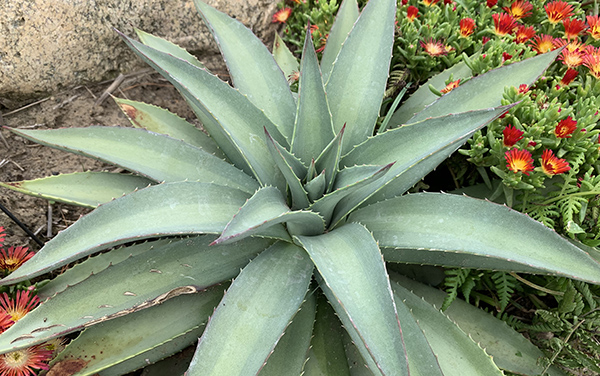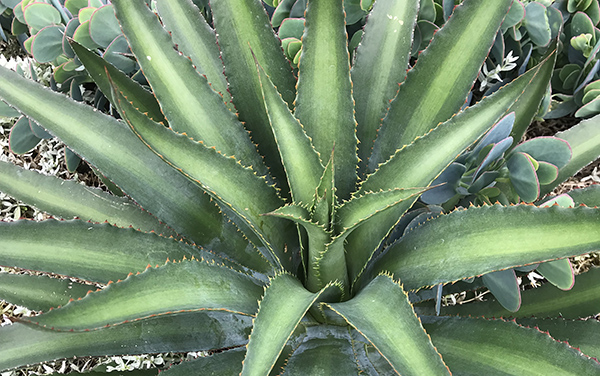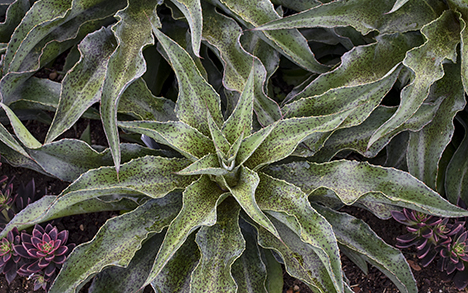An intergeneric hybrid, Mangave inherits the best of its parents. Agave lends durability and large, architectural form. Manfreda gives unique coloring and spotting, as well as softer spines that make them easy to handle.


Between Manfreda and Agave there are hundreds of forms. Mangave covers the entire range of forms; from arching deciduous leaves to rigid symmetry.

Enjoy the succulent size and form of Agave without all the pokes and scratches. Most varieties follow their Manfreda genes with soft spines, making Mangave more user friendly.
Forget the “Thriller, Filler, Spiller” model, Mangave can stand alone with long lasting interest whether planted in a container or the landscape.

Skip the years it takes to get size out of an Agave with the faster growth rate of Mangave. Got it to the size you want? Water sparingly to hold its size.

Mangave are a happy accident. The first Mangave was created by unintentional cross pollination and discovered in a batch of Manfreda seedlings. This plant was passed between friends as a unique curiosity, catching the eye of our breeder, Hans Hansen. While we did not invent Mangave and this first hybrid wasn't discovered in our greenhouses, Hans saw the potential of this plant and has devoted significant time and resources to its development.
Hans and his team have been working not only with Mangave, but with Agave and Manfreda as well. Working with the parents has helped Hans to develop plants that will pass favorable and unique characteristics to create the most interesting Mangave varieties. Hans has made thousands of unique crosses to date and has chosen only the most exotic to add to the collection. With each new generation of plants, Hans discovers more characteristics and curiosities to include in future introductions.

Make sure you give this succulent plenty of room to grow so it can achieve its maximum potential. Wide, broad silvery green leaves are covered with burgundy flecks and form a very large rosette.
Height: 20-24", 50-61cm
Width: 38-42", 96-107cm
Available: USA

Narrow, flat lime green leaves form an arching habit. Each leaf blade has light blush red spotting with a distinct blush toward the tips of the leaves. This is very easy to handle due to its soft, flexible leaves.
Height: 8-10", 20-25cm
Width: 18-20", 45-51cm
Available: USA | JP

Long, flat, lance-shaped leaves are so heavily spotted that they appear solid black. In containers, the leaf tips of this succulent will arch downward. Provide plenty of UV light to get true dark color.
Height: 8-10", 20-25cm
Width: 20-24", 50-61cm
Available: USA

Green leaves are heavily spotted with clear red coloring. The leaves are so heavily spotted that the leaves appear to have solid red bands with green margins. A relatively low profile to the compact habit.
Height: 6-8", 15-20cm
Width: 12-14", 30-35cm
Available: USA

Very thick, silvery blue-green leaves are generously covered with restrained dark spotting. The margins curl upward to show off its marginal teeth. Its upright habit makes it equally attractive from the side and top.
Height: 8-10", 20-25cm
Width: 18-20", 45-51cm
Available: USA

Vivid color palette of red, purple, and green. Each long, broad leaf has a central band that is burgundy red, while the surrounding margins are deep purple with hints of olive green.
Height: 10-12", 25-30cm
Width: 28-32", 71-81cm
Available: USA

A low, spreading rosette with long green leaves containing chocolate spots and wavy-edged margins. Narrow, creamy white margins have cherry red spotting.
Height: 6-8", 15-20cm
Width: 30-32", 76-81cm
Available: USA

A ground-hugging succulent. Wide, twisty leaves are minty green and overlayed with dark purple spots. The perfect choice for the landscape or a low, wide container.
Height: 6-8", 15-20cm
Width: 22-24", 56-61cm
Available: USA

Cascading, thick, blue-green leaves have very faint spots that are more pronounced in UV light, highlighting the three-dimensional nature of the plant. Leaves fold upward to display heavily toothed margins.
Height: 8-10", 20-25cm
Width: 28-30", 71-76cm
Available: USA | AU

Wide leaves have serrated margins that form an upright habit. Gray-green leaves appear to be lightly airbrushed with burgundy; dark spots cover the leaves.
Height: 6-8", 15-20cm
Width: 16-20", 40-51cm
Available: USA

Minty green leaves have a lavender overlay and are lightly freckled with dark burgundy spots. The “freckles” and overlay are more pronounced in direct sunlight. Margins curl up slightly to showcase its white, serrated edge. Rose pink terminal spines.
Height: 8", 20cm
Width: 16-20", 40-51cm
Available: USA | JP

A dreamy, ethereal looking succulent with unique coloration. Silvery blue arching leaves have soft green central bands. The glaucous color is a product of the waxy film that covers the leaves. A beautiful addition to any garden or container.
Height: 6-8", 15-20cm
Width: 12-14", 30-35cm
Available: USA

Thick, wide, dark green leaves with blood red spotting arch downward to form a low, wide habit, perfect for framing decorative containers. More exposure to UV light will bring out the dark coloration and the spotting.
Height: 6-8", 15-20cm
Width: 18-22", 45-56cm
Available: USA | EU

Trigeneric cross of Agave, Manfreda, and Polianthes. Hansara inherit the characteristics of the Mangave cross (Manfreda x Agave), with the addition of more upright habits and flexible leaves from their Polianthes parentage. Long, narrow, upright green leaves have a slight bronze overcast and light burgundy speckling.
Height: 14", 35cm
Width: 24", 61cm
Available: USA

A unique, feminine beauty with a solitary rosette habit and smoky purple coloration. In direct sunlight, smoky purple, ovate leaves are formed at the top of the rosette and have subdued burgundy-purple dots. The leaves lighten to green with age. Tiny white, fairly benign marginal spines. Cinnamon brown terminal spine.
Height: 8-10", 20-25cm
Width: 12-16", 30-40cm
Available: USA | EU | AU

Long, silvery succulent, blue-green leaves with near-black spotting form a ground-hugging, low habit. Compared to ‘Chocolate Chips’, this plant has wider leaves, darker spotting, and more silvery blue leaves.
Height: 6-8", 15-20cm
Width: 18-24", 45-56cm
Available: USA

An homage to the Red Planet due to the unique, intense red coloration of the leaves. Wide, green leaves form an arching habit and are heavily speckled with burgundy red, with spots that bleed into each other for an overall red appearance.
Height: 8-10", 20-25cm
Width: 20-22", 51-56cm
Available: USA | EU | AU

Cool-looking, silvery blue-green leaves practically glow with huge, contrasting dark purple spots. More UV light levels will enhance the spotting. Flat leaves are held rigidly straight from the base, forming a low, wide, and spiky habit. Relatively soft to the touch.
Height: 8-10", 20-25cm
Width: 16-20", 40-51cm
Available: USA | EU | AU | JP

Clear and consistent variegation. Wide, cream margins are contrasted by deep blue-green centers. The rigid leaves form a relatively low horizontal habit. Minimal spotting near the crown is secondary to the bright green and cream color. Compared to ‘Snow Leopard’, ‘Navajo Princess’ has thicker, more heavily toothed leaves and offsets less frequently.
Height: 8-10", 20-25cm
Width: 18-20", 45-51cm
Available: USA

This beautifully dark succulent has a similar habit as ‘Silver Fox’ but with near black leaves. Its dark color comes from its heavy dark spotting. The wide leaves gently undulate to show off its marginal spines. Plant in full sun for best color.
Height: 6-8", 15-20cm
Width: 16-18", 40-45cm
Available: USA

Olive green leaves have a distinct lighter central band that is covered in red dots if exposed to UV light. Overall, the leaves have a dusty burgundy wash. The habit is upright, perfect for underplanting in containers.
Height: 8-12", 20-30cm
Width: 18-20", 45-51cm
Available: USA

Refined, spiky habit reminiscent of the top of a pineapple. One inch wide, dark green leaves are long and slender with pronounced burgundy spotting, brought out with UV light. Waxy coating gives the leaves a minty-green finish.
Height: 9-10", 23-25cm
Width: 16-18", 40-45cm
Available: USA | EU | AU

A totally different look than what you’ve seen in Mangave so far! Dark green leaves curl upward like a teardrop, where the cinnamon brown terminal spines nearly touch each other. ‘Praying Hands’ gets its unique habit from one of its parents, Agave ocahui.
Height: 8-10", 20-25cm
Width: 8-10", 20-25cm
Available: USA

A neat rosette of thick, sturdy leaves that are blue-green with dense reddish-purple spotting that causes the leaves to appear purple. Best coloration in full sun. Margins fold upward to show off its yellow, orange, and cinnamon brown spines. Each leaf has a cinnamon terminal spine.
Height: 12-16", 30-40cm
Width: 16-24", 40-61cm
Available: USA

A central band of light green complements dark green margins. Leaves are stiff but arch down slightly. ‘Center of Attention’, ‘Racing Stripes’, and ‘Shadow Waltz’ all have central stripes, but all are from different species of Agave and grow very differently.
Height: 14-18", 35-45cm
Width: 22-28", 56-71cm
Available: USA

This succulent forms a very large, refined rosette comprised of a multitude of pronounced deep red leaves. Absolutely gorgeous for both containers and the landscape.
Height: 16-18", 51-56cm
Width: 24-26", 61-66cm
Available: USA | EU

Long, narrow, dark green leaves have a lighter central band. Stiff leaves have soft marginal teeth that are easy on the fingers. The habit is relatively low to the ground, especially on young plants. Leaves arch with age to form a compact, upright habit.
Height: 10-12", 25-30cm
Width: 22-24", 56-61cm
Available: USA

Light green leaves are covered with a thick waxy coating, giving it the appearance of glowing white. Light blue-purple spotting is visible underneath the coating. A magnificent habit, of thick, arching leaves and defined marginal teeth.
Height: 8-10", 20-25cm
Width: 16-18", 40-45cm
Available: USA | EU | JP

Variegated sport of ‘Jaguar’ with the long, lance-shaped leaves of the parent and creamy white margins. Some cherry red spotting exists in the margins, but the variegation appears clear from a distance. Compared to ‘Kaleidoscope’, this has white margins (versus yellow) and dark spots that cover the leaves and are pink in the margins. UV light enhances the spots.
Height: 16-18", 40-45cm
Width: 22-24", 56-61cm
Available: USA

The compact silver-gray rosette is lightly peppered with red flecks. Pronounced teeth line the margins and culminate in a terminal spine.
Height: 4-6", 10-15cm
Width: 12-14", 30-35cm
Available: USA

Medium green leaves are covered with small, dark burgundy purple spots, folding up at the margins to display sienna orange marginal teeth and long terminal spines. Softly wavy leaves completely overlap each other, leaving little to no gaps.
Height: 10-12", 25-30cm
Width: 24-30", 61-76cm
Available: USA | AU

Long, pronounced spines come in a rainbow of colors, ranging from cinnamon brown to yellow to orange. Blue-green leaves show off the colors even more, with faint spotting giving the thick leaves extra character. Forms a singular rosette.
Height: 10-12", 25-30cm
Width: 16-18", 40-45cm
Available: USA | AU
Mangave is a tender perennial or "temperennial" succulent plant. These hybrid plants are relatively new and don't behave like normal succulents. While you can grow and treat them like the average succulent plant, there are differences and benefits to properly grow a Mangave.
There are many ways in which Mangave compare to normal succulents. Both of these plants prefer a well-drained, dry to average soil and should be situated in containers just slightly wider than the width of the rosette. The majority of succulents, Mangave included, are best when situated in full sun or an area with a lot of natural light. However, Mangave can also be planted directly in the ground and add tremendous landscape value.
Mangave are best when grown with a lot of sun. These plants grow best when situated in an area with extended natural light. Artificial or low lighting will cause fading of the bright colors and distinctive spotting. Mangave leaves will regain their spots if moved to an area with more light.
We think of succulents as drought tolerant, but really they are water sensitive. Too much water and they rot away, too little and they don't grow. Enter Mangave. This super-sized succulent is much more water tolerant and grows much quicker because of it. Happy with your Mangave at the size it is? Water it sparingly like a normal succulent to slow it down.
Agave and Manfreda are native from the Southeastern United States through to South America. You will probably never find a Mangave growing in the wild because of how infrequently both Agave and Manfreda flower, making cross pollination unlikely. It is thanks to the collectors and hybridizers of unique plants that this original cross was possible.
With both parents native to alpine and desert areas, this characteristic is ingrained in their succulent DNA.
The tolerance varies based on the parent species. Most Mangave van be safely overwintered in areas where temperatures drop to 20 - 30°F (-7 - -1°C), with some doing well down to 10°F (-12°C).
Mangave are unlike most succulents who either don't get that big or take a long period of time to fill a container. Their fast growth rate, interesting colors, and architecture allow Mangave to fill large pots and patio containers. Use them in combination with other succulents or to stand alone in a mono pot.
It is best to plant a Mangave in a well drained soil. If a Mangave is allowed to sit wet for too long the roots may begin to rot. Mangave grown in containers should be planted with a succulent or bark soil mix. Sandy or rocky soils are among the best if you are placing your Mangave directly into the ground. If you are worried your soil is too heavy or has too much water, you can try amending the area around your Mangave with a succulent or bark soil mix.
If you have the ability to test for Soil pH or EC and adjust your soil, we recommend targeting a pH of 6.2-6.8 and an EC of 1.0-1.25 using the pour through method.
Although Mangave share many traits with annuals and perennials, we recommend using a fertilizer designated for succulent use and following the instructions on the package. Avoid overfertilizing; extra nutrition is not beneficial to Mangave.
If you do not live in an area where a Mangave will naturally overwinter, you will need to bring it inside to an environment that is kept at 60°F (15°C) or warmer. You should also place it in an area where it will get as much natural light as possible. If your Mangave is closeted away from a good light source it will begin to stretch and the leaves will lose their substance.
Deer are known to tear apart gorgeous patio containers and garden beds. Mangave are rarely bothered by browsing animals thanks to their thick leaves, as well as marginal and terminal spines. An animal might dig up and chew on the roots if they are hungry enough. They are also less likely to be bothered by aphids and other insects which are known to chew holes in the leaves of annuals, perennials, and shrubs.